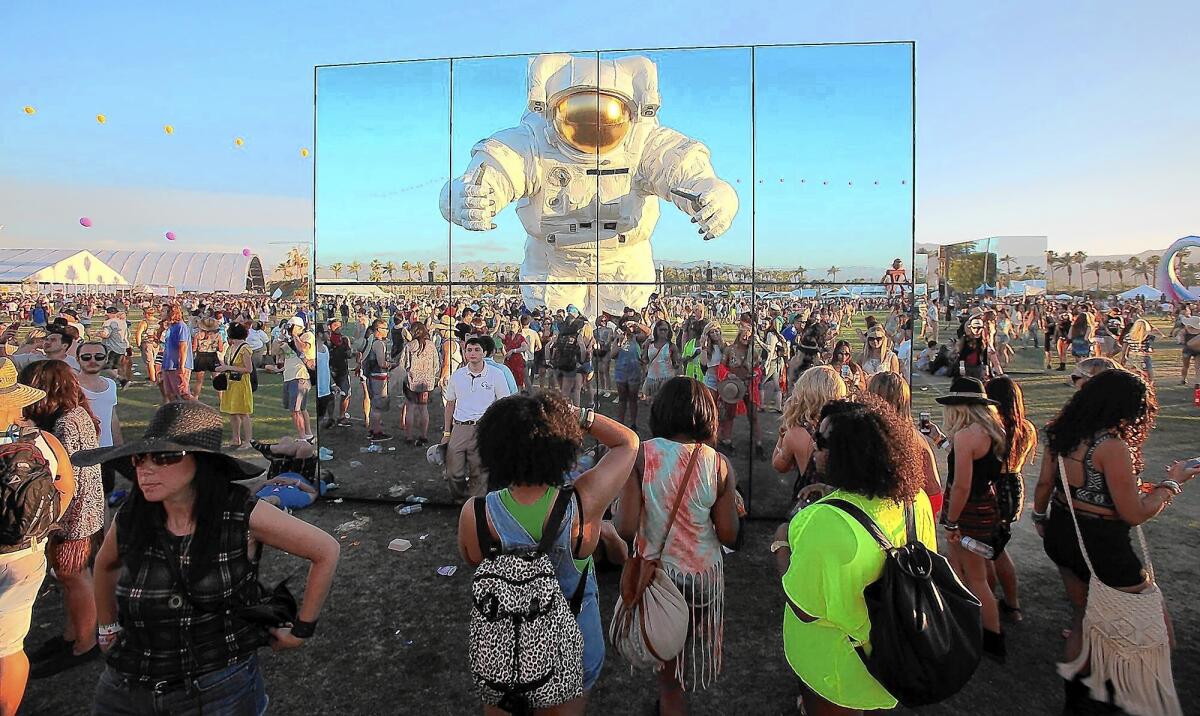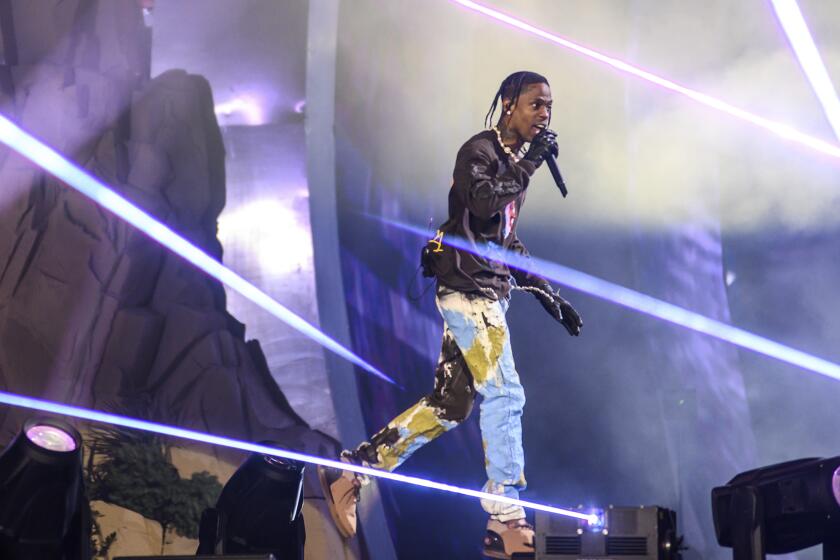A more upscale Coachella still has some fun ragged edges

INDIO — The Coachella Valley Music and Arts Festival has been referred to by some as Bro-chella since at least 2008, when the annual desert gathering featured such dude-friendly headliners as Jack Johnson and Roger Waters.
The latest edition, which ran Friday through Sunday at the Empire Polo Club before repeating this weekend, had a bit of the bro about it, with performances by dub step king Skrillex, stoner-rap MC Kid Cudi and jock-jammy alt-rockers Foster the People. But a different atmosphere seemed to settle over the festival during its initial three-day blast.
Its name: Pro-chella.
PHOTOS: Coachella Day 1 | Day 2 | Day 3
Widely considered America’s most glamorous festival (thanks to its scenic locale and its appeal to young Hollywood), the event in its 15th year rolled out some remarkable creature-comfort upgrades, including a reservation-only four-course dinner and a so-called beauty studio sponsored by the cosmetics maker Sephora.
The sophisticated vibe stretched to the festival’s musical programming, which for the most part emphasized polish and professionalism over the scrappier spirit of rebellion that defined Coachella in its early years. Often it seemed the only grit in the Indio air was the dust that blew up Saturday as a result of high desert winds.
Some of this derived from a lineup heavy with established mainstream acts. While the festival’s estimated crowd of 90,000 each weekend means it can book superstars — Prince, Paul McCartney and Kanye West have all played Coachella — the 2014 show felt especially pop-oriented across its six stages, with Top 40 fixtures such as Lorde, Pharrell Williams and Ellie Goulding doing huge hits familiar to listeners well outside any tastemaker elite.
There were also unannounced appearances by a smattering of A-list names: Jay Z, who rapped with his former rival Nas; Beyoncé, who danced (but didn’t sing) with her sister Solange; and Justin Bieber, who presumably turned up to get his picture on Instagram.
Yet even lesser-known artists brought high-end spectacle to Coachella in the form of elaborate stage productions. On Friday night, the Swedish electro-pop group the Knife performed a kind of avant-garde musical, complete with choreography, based on its album “Shaking the Habitual.” Sleigh Bells had strobe lights as blinding as its electric guitars were deafening.
And in the Sahara tent, Coachella’s hangar-sized home for electronic dance music, Martin Garrix and Zedd set their slamming beats to trippy, intricate video sequences that seemed designed to alter minds that weren’t altered already.
For Coachella, the display was a means of ensuring its destination status in an increasingly crowded festival scene. This summer many of the acts playing in Indio — including the reunited Atlanta hip-hop duo Outkast, which performed Friday night for the first time in seven years — are scheduled to hit Lollapalooza, Bonnaroo, Outside Lands and others.
What better way to preserve a competitive advantage than to promise man-made extravagance amid the desert’s raw beauty?
Coachella’s upscale quality also reflected pop’s fixation on refining old sounds. All weekend long, artists were reaching back for source material to slicken or clarify using modern technology, as Solange and Blood Orange did with the textures of 1980s-era R&B and Laura Mvula did with Nina Simone’s orchestral soul.
Aloe Blacc, another Top 40 hit maker at Coachella, channeled Motown-style energy in his zippy Friday-afternoon set, for which he was backed by an airtight band in color-coordinated shirts and ties.
PHOTOS: The past headliners at Coachella
Not youngsters going retro but real-deal old-timers, the members of New Orleans’ Preservation Hall Jazz Band dressed up too despite the heat — part of a crew of nattily attired veterans here that also included Bryan Ferry and Pet Shop Boys.
Given Coachella’s sprawl, there were, of course, exceptions to this finesse. New York’s ASAP Ferg was rowdy and proud of it in a no-frills rap show full of macho posturing. Singer Samuel T. Herring of Future Islands sang and danced with an endearing awkwardness as his band churned out lumpy synth-rock grooves.
And for all the excitement about their return to performing, Big Boi and Andre 3000 of Outkast disappointed some fans with their headlining set; ditto Williams, who blamed the wind on Saturday night for wrecking his voice and portions of his stage production.
But only Julian Casablancas used the tools of sophistication to critique lavishness itself. Playing Saturday with a new group he’s calling the Voidz, the Strokes frontman blazed through a set of unreleased songs that combined precisely slashing guitars and breakneck digital-punk beats with barely comprehensible lyrics full of sneering seen-it-all disgust.
It wasn’t a repudiation of the Strokes’ streamlined garage pop so much as a kind of sour extension of it. Which didn’t make it an easy sell: After only a few songs, a steady stream of people, evidently disappointed with the singer’s harsh new sound, began filing away from the stage.
But Casablancas was OK with that. “This music was meant to alienate the right people,” he said, a welcome (and thrillingly unexplained) flashback to Coachella’s unruly past.
More to Read
The biggest entertainment stories
Get our big stories about Hollywood, film, television, music, arts, culture and more right in your inbox as soon as they publish.
You may occasionally receive promotional content from the Los Angeles Times.







